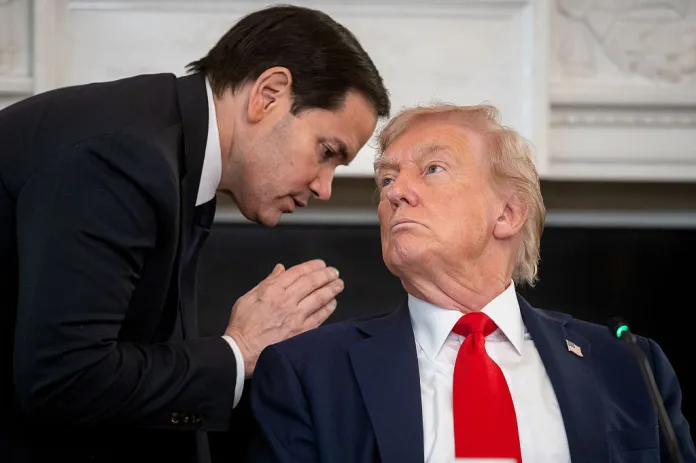Whenever the president is interrupted at an event with a whisper or note from an aide, something significant and possibly historic is afoot.
Perhaps the most memorable example in recent times is when White House chief of staff Andy Card approached President George W. Bush on Sept. 11, 2001, while he was reading to students at Emma E. Booker Elementary School in Sarasota, Florida, to inform him that the nation was under attack.
President Donald Trump received far better news when Secretary of State Marco Rubio notified him that a peace deal between Israel and Hamas was close, just a day after the war in Gaza following the brutal terrorist attack against the Jewish state hit the two-year mark.
Trump is a master of big media moments. The event Rubio interrupted was meant to highlight the prevalence and severity of antifa violence across the country. Many reporters were likely hearing about this criminal behavior for the first time.

Rubio came in to tell the president so that he could announce the agreement, the first phase of what is hoped to be a larger peace deal, himself on Truth Social. If every Israeli hostage is returned and the ceasefire holds, the image of Rubio whispering to Trump and passing him a note will go down in history alongside the three-way handshake between President Jimmy Carter, Israeli Prime Minister Menachem Begin, and Egyptian President Anwar Sadat.
The substance matters here more than the style. Peace in the Middle East has been elusive, though the Abraham Accords marked Trump’s first-term contribution to the cause. Ending the war in Gaza, if that proves to be possible, would constitute a much greater breakthrough.
Trump would also have accomplished it by ignoring the advice of allies and domestic political opponents who argued that pressuring Israel and preemptively giving the Palestinians statehood was the way to peace. To be sure, Trump has at times nudged Israel. At the conclusion of the 12-day war with Iran, he let a little frustration with Prime Minister Benjamin Netanyahu — “They don’t know what the f*** they are doing,” the president complained when it looked like hostilities might resume — but has also been resolute against the Jewish state’s enemies.
A certain unpredictability has characterized Trump’s diplomacy, perhaps especially when it succeeds. While Trump is more willing to project military force and countenance its use by allies than some members of his electoral coalition (myself included), the man who wrote The Art of the Deal would prefer to go down in history as a master deal-maker and peacemaker rather than a warfighter. He might be able to earn that reputation. “BLESSED ARE THE PEACEMAKERS!” Trump exclaimed at the end of his Gaza deal social media post. (Yes, the all caps were in the original.)
Such a celebration would be appropriate to mark the end of the hostages’ ordeal and the humanitarian toll of the bloody war. Israel has inflicted serious damage on its enemies, which is why Hamas was willing to accept Trump and Netanyahu’s terms. But it came at some cost in terms of international isolation, which was always a major Hamas war aim. Seeing who did and did not cheer the possible conclusion of this war was illuminating.
WHAT THE TIMELINE OF THE GAZA PEACE DEAL LOOKS LIKE
Now the world faces the question of what comes next. Disarming Hamas and forming a peaceful, responsible government in Gaza that has credibility with the Palestinian people will be major undertakings. Even the earliest phase of a Gaza peace deal could prove fragile as conditions shift like the sand in the Middle East.
For now, we have a picture that is worth a thousand words. But its real value will come in terms of how many saved lives it ultimately represents. We can only hope and pray that it is an image that endures.
W. James Antle III is executive editor of the Washington Examiner magazine.

